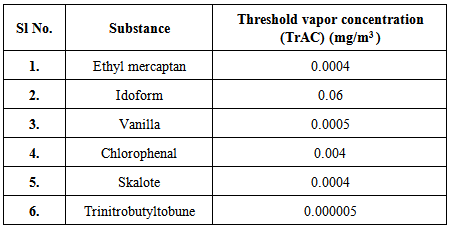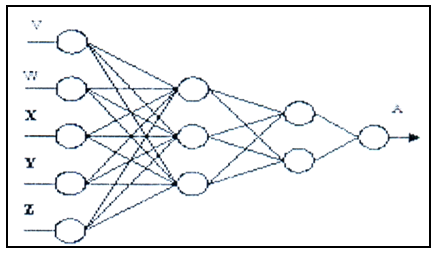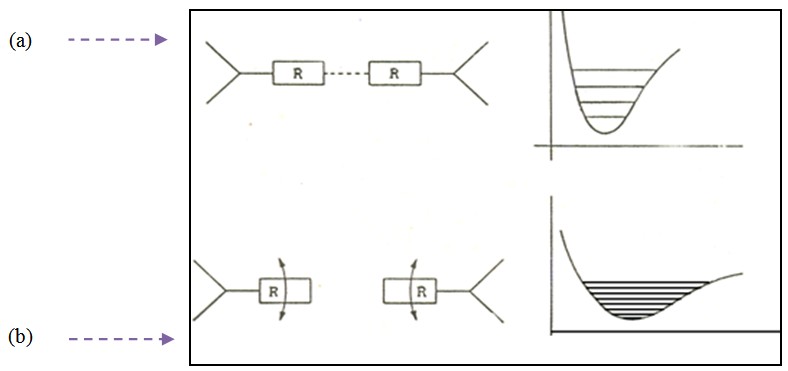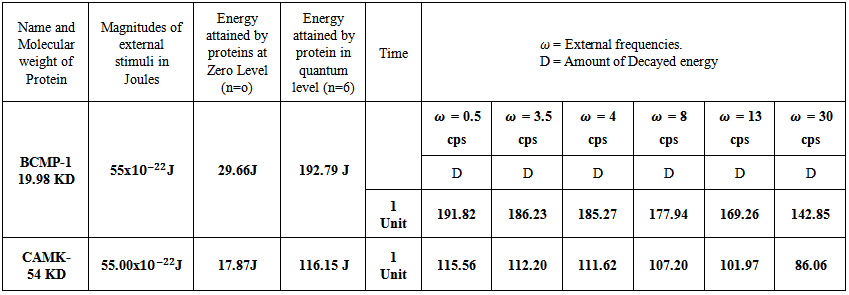-
Paper Information
- Paper Submission
-
Journal Information
- About This Journal
- Editorial Board
- Current Issue
- Archive
- Author Guidelines
- Contact Us
International Journal of Biophysics
p-ISSN: 2168-4979 e-ISSN: 2168-4987
2014; 4(1): 16-22
doi:10.5923/j.biophysics.20140401.03
Smelling - A Pathway to Instant Memory
Brajagopal Majumder
State Resource Centre, Agartala, Tripura, India
Correspondence to: Brajagopal Majumder , State Resource Centre, Agartala, Tripura, India.
| Email: |  |
Copyright © 2014 Scientific & Academic Publishing. All Rights Reserved.
Reason of feeling smell is discussed. The anatomical and physiological aspects of olfactory system are discussed. The role of odorant molecules and receptor protein are discussed in detail. Focus is paid on the discriminating system of not only 10,000 odorants but more. The process of interpretation of the input signal in brain is proposed as creating vibration in protein present in concerned places of the brain. Frequent vibrations of light protein lying particularly within dendrites are proposed responsible for feeling smell. Feeling smell is suggested as instant incident as protein generated in dendrites is also transient in nature. The smell erased as soon as the vibration of the transient proteins cease. Genetic interpretation of smelling opens the door of curing some phobia and epilepsy type diseases.
Keywords: Olfactory system, Receptor proteins, Odorants, Discriminating, Action potential, Chemical signals, Interpretation of brain transient proteins
Cite this paper: Brajagopal Majumder , Smelling - A Pathway to Instant Memory, International Journal of Biophysics , Vol. 4 No. 1, 2014, pp. 16-22. doi: 10.5923/j.biophysics.20140401.03.
Article Outline
1. Introduction
- In 2004, Nobel Prize awarded to two American neuroscientists Limda Buch & Richard Axel for their contribution in identification of the gene, which control smell. Their findings first published in early 1990s [1]. Their findings are now generating some surprising insights. These may support the deliberation of Andreas Keller, a geneticist working in the Rockfeller University in New York City. Andreas [2] held as, “When I give talks, I always say that everybody in this room smells the world with a different set of receptors, and therefore it smells different to everybody”. The human nose contains 400 olfactory receptors. Each receptor responds to several odorants and each odorant encoded by different genes. Boris Schilling [3] – a biochemist of Givaudan held “Unless you are dealing with identical twins, no two persons will have the same genetic make up for those receptors”. The reason for this, as Doron Lancet [4] expressed “these genes have been accumulating mutation by evolution”. He further added, “Smell has gradually become less important to survival, having been replaced to some extent by color vision as an indicator for rotten fruits”.When deleterious mutation occurs in a certain gene, it ceases to produce a working receptor & hence becomes a pseudo gene. Here, also some peculiar findings occur. Almost all people may have the same proportion of pseudo genes. However, each may have different ones resulting in different genetic “bar code” and different combination of olfactory sensitivities.A study conducted by Keller [5] and his colleagues over 500 people to rate 66 odors for intensity and pleasantness reveals that the responses covered the “full range like intense to weak and pleasant to unpleasant with most lying in moderate range and making a classic bell curve in each case.” The researchers also tested people’s responses in their subconscious states and it is observed that the volunteers in their subconscious states are less responsive to smelling rather they showed physiological responses to the odorants like “an increased skin inductance due to minute increase in perspiration”. From these observations, Keller held that “there’s a surprisingly large variability in all those measures, and maybe more so in the subconscious than in the conscious measures”, Conducting a test on smelling of a compound namely, androstenone produced in boar’s test Chuck Wysocki held that “for 50 percent of the people androstenone is nothing, for 35 percent it is very powerful stale urine smell and for 15 percent it is a floral, musky, woody note”. From these observations, Keller and his colleague held that a person inherits a gene called OR7D4 for which he perceives androstenone. They further added that it is such genetic behavior of the person, which links to the domain of smell for the individual. A genetic analysis conducted by Thomas Hummel and his colleagues [6] over 3000 volunteers revealed that specific anomies are significantly related to the molecular weight of the odorant”. Hummel also added, “Smaller, simpler molecules are more likely to fit the binding process of several receptors, making them detectable even if one of these receptors is not working”. On other hand, a heavier and more complicated molecule might only bind to one specific receptor and it becomes undetectable if the receptor is a pseudo gene. Binding of receptor to one or a very few odorants triggers an electrical signal to the brain. However, the brain perceives “the result of combination of incoming signal from all receptors”. In support of one olfactory puzzle- why some people are more sensitive overall to smells than other is, Lancet [4] held “it is protein which ensures the efficient transmission of the signals elicited by those receptors to higher processing areas in the brain- the transmission pathways that are shared by all receptors”.Earlier it held that people could discriminate not more than 10,000 odors, but the latest findings show that our nasal system can discriminate more and at present, it estimated as one trillion. Hence, Leslie Vosshall [7] held that nose is really like “a massive broadband technology that can take huge amount of information and pass it to the brain”. A study was conducted by Prof. Vosshall & Andreas Keller with mixtures of 128 odor molecules derived from scents such as orange, anise and spearmint over a number of volunteers making a group of 26 volunteers. Each of the 26 volunteers- 17 women & 9 men had to discriminate smells from the mixtures, which were made from groups of 10, 20 & 30 different odor molecules.“The volunteers were given three vials to smell, two of which were identical. They asked to pick up the odd one. The third one starting out the same as the other two gradually altered to become more different”. From these, the researchers were able to manipulate the molecular composition of each odor basing on which nose can make a clear distinction. This results as Keller said, in the message that we have more sensitivity in our sense of smell. The reason for our sensitivity to smell lies in the fact that “human smell relies on two small odor- detecting patches in the upper nasal chamber, each containing about five or six million receptor cells- comprising 400 receptor types- which send signals to the brain directly through olfactory bulb attached to the base of the brain”. However, these number of receptor cells in human nasal system are much less that of rats and dogs having 100 and 220 million of receptor cells respectively. This is the reason that rats and dogs are more sensitive than humans with respect to smells.
2. Dynamics of Human Olfactory System
- Sensory receptors are responsible for feeling smell. These receptors respond to airborne chemicals. In humans, olfactory epithelium- a patch of tissue of a postage stamp size is located in upper part of the nasal cavity. The airborne chemicals known as chemoreceptor’s are located in the olfactory epithelium [8]. The olfactory epithelium is made of three kinds of cells:i) Sensory neurons each consisting of a primary cilium,ii) Supporting cells between these two,iii) Basal cells are responsible for replacing dead cells by producing a fresh crop of sensory neurons.The odor molecules are usually small enough to be volatile so that these can vaporize and reach the nose easily.The olfactory epithelium is located at a distance from the main respitory tract. The inhaled air reaches it by diffusion, which is relatively slow. Alternatively, the inhaled air reaches the olfactory epithelium by means of vertical movements and therefore more quickly. During smelling, vertical movements occur resulting in rapid inhalation through nose. At this moment, nostrils widened to make it easier for inhaled air to enter the upper part of the nasal cavity and reach the receptors there.The olfactory receptors or cells are bipolar neurons between five to ten microns in diameter. The area of the olfactory zone is about five square centimeters while the surface area of the cilia is 100 to 150 time’s great [9].The cilia sensory neurons are immersed in a layer of mucus. Odorant molecules (molecules that we can smell) are dissolved in the mucus and binding to receptors on the cilia. These receptors are known as“7-pass trans-membrane proteins”. Binding of odorant activates a G-protein [8] coupled to the cytoplasm side of the receptor. This activates Adenylyl cyclase- an enzyme embedded in the plasma membrane of the cilia. Adenylyl cyclase catalyzes the conversion of ATP to the “second messenger” cyclic AMP (cAMP) in the Cytosol. cAMP opens up the sodium channels for facilitating diffusion of Sodium in the cell which in turn reduces the potential across the plasma membrane. It generates an action potential when the depolarization reaches threshold.The organs of smell are amazingly sensitive. The threshold concentrations (for man) of various odoriferous substances in the air tabled as [9]:
 The lower the threshold air concentration is, greater is the speed of odorant molecule. The reverse will happen in case of higher air concentration. This means greater the speed is, the stronger is the sensation of smell.Adaptation [9] which means adjustment to the strength of the stimulus is the common property of all receptors. “Adaptation is manifested in a reduction of sensitivity to a constant acting stimulus. When a person, as for example, enters a smoking room, immediately notices the smell of tobacco, but after a few minutes he is no longer aware of it”. This means as soon as the action of a constant stimulus has ceased, the adaptation developed under its influence gradually disappears and the sensitivity of the receptor increases.Some receptors are excited only at the very outset of stimulation (on-receptors) and the others remain non excited when stimulation ceases (off receptors). Still others are excited both at the beginning and at the end of stimulation (on and off receptors). These receptors, however, constitute as sources of constant flow of impulses. These receptors can react with increase or decrease of the frequency of impulses under the action of stimuli.The reasons is that when air containing an odoriferous substance enters the nose and retains there till next breath are taken through the mouth, impulse arise in the olfactory cells initially and then quickly lease on a result of adaption, when comes into play with in a second. Electrophysiological studies give evidence of the presence of continuous flow of impulse through the fiber of the olfactory tract. Odors can change the character of these impulse (frequently and grouping in serious) and it occurs exactly in that way that olfactory information is transmitted.The impulse then gets into neuron. The process of interconnected neuron receiving many inputs and producing single output as proposed by Arfin and Saha [10] is represented in the Fig-1.
The lower the threshold air concentration is, greater is the speed of odorant molecule. The reverse will happen in case of higher air concentration. This means greater the speed is, the stronger is the sensation of smell.Adaptation [9] which means adjustment to the strength of the stimulus is the common property of all receptors. “Adaptation is manifested in a reduction of sensitivity to a constant acting stimulus. When a person, as for example, enters a smoking room, immediately notices the smell of tobacco, but after a few minutes he is no longer aware of it”. This means as soon as the action of a constant stimulus has ceased, the adaptation developed under its influence gradually disappears and the sensitivity of the receptor increases.Some receptors are excited only at the very outset of stimulation (on-receptors) and the others remain non excited when stimulation ceases (off receptors). Still others are excited both at the beginning and at the end of stimulation (on and off receptors). These receptors, however, constitute as sources of constant flow of impulses. These receptors can react with increase or decrease of the frequency of impulses under the action of stimuli.The reasons is that when air containing an odoriferous substance enters the nose and retains there till next breath are taken through the mouth, impulse arise in the olfactory cells initially and then quickly lease on a result of adaption, when comes into play with in a second. Electrophysiological studies give evidence of the presence of continuous flow of impulse through the fiber of the olfactory tract. Odors can change the character of these impulse (frequently and grouping in serious) and it occurs exactly in that way that olfactory information is transmitted.The impulse then gets into neuron. The process of interconnected neuron receiving many inputs and producing single output as proposed by Arfin and Saha [10] is represented in the Fig-1. | Figure 1. Olfactory Receptor’s communication directly with the brain shown in (a) & (b). (Curtsy internet) |
 | Figure 2. Graphical representation of interconnected neurons |
3. Interpreting Function of the Brain
- Humans are capable of discriminating between thousands of different odor molecules- each with its structure. The mammalian genome contains a family of about 1000 related receptor. However, there are separate encoding odor receptors. Each gene encodes a trans-membrane protein. These proteins resemble each other but not identical. These encoded proteins contain 7 regimes of hydrophobic alpha helix which help in passing molecules 7 times through the plasma membrane. Some portion of the molecule exposed outside the cell may be responsible for binding the odorant-molecule. Many odorant molecules are hydrophobic and can easily enter the lipid bi-layer and bind to the receptor there. Only a single type of receptor binds to only 1 (one) in a 1000 sensory neurons in a normal olfactory epithelium.A single olfactory neuron contains over a thousand receptor genes. However, there is only a single enhancer capable of binding to the promoter of these genes and function them on. Practically speaking, there are two enhancers while one methylated (active) and the other is not. When the active enhancer encounters the promoter of an olfactory gene, it turns it olfactory gene on and stops its search. Thus, only one olfactory receptor gene expresses in a single cell. However, categorization of the olfactory gene is a matter of chance.The above mechanism tells as:-Each receptor is capable of binding to different odorants. This forms the basis for combinatorial diversity. The working hypothesis [8] is assumed as: Odorant A binds to receptors on neurons #3, #427 & #886.Odorant B binds to receptors on neurons #2, #427 & #743.The brain then interprets the two different patterns of impulses on separate odor or if the two odorants are mixed, it will interpret a unoaked chardonnay with A, 3, 427, 886 & B, 2, 427, 743 as a bouquet of berry fruits [11].The study of discriminating128 odorants by Vosshol and A. Keller with a group of 26 volunteers as discussed earlier is regarded as a unique practical evidence of discriminating number of odorants. Now the question is- how the brain interprets these signals reaching it in the form of impulses of action potential or chemical signals? A good number of researchers conducted studies on olfactory mixtures and focused on electrophysiological readings of single undefined ORNS and some of them showed that mixture-specific interactions occur at the peripheral level. However, following the studies of Mombaerts et al. on Drosophila and Vosshall, Nina Deising and others [12] showed “the number of the component information present in mixture representation”. The scholars also viewed that “an important endeavor of their study was analyzing the activity from clearly identified neuronal structure over different animals, which requires the reliable identification of individual glomeruli across individuals”. The explanations put forward by different scholars are not beyond controversies as the scholars are interested with the final output of the input signals after interpretation in the brain but not with the process of interpretation. Since the particular portion of the brain is concerned with neural proteins, the author hypotheses the whole picture of interpretation of smelling differently.In a recent paper [13] the author attempts to explain the functioning of the brain with respect to memory traces from the view point of his suggestion of protein vibration responsible for recalling the learnt events. However, it is a fact that protein vibrates not only due to external stimuli but also due to electrostatic force generated in it. Kovalyoba [14] held the view that “when an electric signal gets to neuron, the structure of the membrane lipid is changed and they pass in to a new state with intensifying RNA activity and its constituent protein synthesis. If the cell does not undergo any change, nothing is recorded”.This means as soon as the impulse gets to a neuron, the structural change of the membrane lipid occurs and during this phase of structural change, vibrations occurring in protein-expected to be responsible for memory formation. The more the stability of protein is, the more is the memory.The author in a recent paper [15] showed that the recalling of the learnt event depends on the number of frequencies of vibration in protein. However, during smelling vibrations occur very frequently with rapid structural change. These proteins are transient in nature. As a result, smelling disappears as soon as the vibrations cease.The problem of protein vibration responsible for memory was considered [13] in the light of the solution of the standard form of Schrodinger Equation.Inserting the potential energy function v = ½ kr2 in one dimensional Schrodinger Equation
 | (1) |
 | (2) |
 | (3) |
 | (4) |
 | Figure 3. Vibrations of Protein shown in figure (a) represents stable protein & (b) represents transient protein |
4. Results & Discussion
- From the suggestion of forming new synapse and growing new dendrites with chemical changes at the synapse due to entry of particular smell impulse, the locally synthesized proteins may broadly be classified as short lived dendrite proteins.Ouyang et al (1999) observed rapid synthesis of CAMK ii α following synaptic plasticity. Miller et al. (2002) assessed the synaptic mRNA and measured the levels of CAMK ii α protein in the postsynaptic density which is reduced by 83%.All these data suggest that most of the CAMK ii α protein is made locally in the dendrite during normal brain function. Hence, our proposed group of protein may belong to dendrite group. These respond rapidly in the form of vibration with the incoming signal and their levels also reduce quickly resulting in ceasing of vibration. These are proposed to happen in case of smelling.In a paper [15], decay energies of proteins of small molecular weight with respect to external frequencies were calculated on the basis of our proposed approaches of vibration in proteins. As for examples, the result due to BCMP-1 and others are tabulated in Table-1.This supports our proposal of synthesis of proteins of small molecular weight during smelling. It is an established fact that BCMP-1 having molecular weight 19.98 KD is responsible for memory traces in case of humans and also for dogs. Dogs having 220 Million of receptor cells are more odorant friendly than humans. BCMP-1 is identified as epithelial membrane protein and it plays significant role in smell identification by dogs. Thus it reveals that the frequencies generated due to vibration in locally synthesized dendrite protein may play active role in interpreting the impulse or chemical signals transmitted to the particular portion of the brain.The nose is the organ of mammals to distinguish between different kinds of odors and hence, to estimate the olfactory power of human. From the identification of genes by Linda Buck and Richard Axel, it is established that each of us inhabits our own personal olfactory world. This is echoed in the quotation of Keller as mentioned earlier. This is reiterated, “When I give talks, says Andreas Keller, I always say that everybody in this room smells the world with a different set of receptors and therefore, it smells differently”.Lancet [4] suggests that genetic tools will help the researchers to solve an interesting puzzle- : “some people are more sensitive overall to smells than others?” It is reported that “one in 5000 people is born without any sense of smell at all, while at the other end of the spectrum are those individuals who have a higher than average general sensitivity. Some of whom may gravitate to the perfume industry.” The reasons advocated not for the presence of “olfactory receptors responsible for specific anomies’ but the proteins which ensure the efficient transmission of signals elicited by those receptors to higher processing areas in the brain”.
 | Table 1. Vibration Energy of Proteins with respect to time and frequencies Weight/mass of protein = 19.98 KD and 54 KD |
ACKNOWLEDGEMENTS
- The author expresses his thanks to D r. U.C. Dey, Assistant Prof. Dept. of Chemistry Tripura University. The author is also thankful to Mr. D. Banik, Mr. Tanuj Sharma and Mr. Rajib Malla Program Co-coordinators, SRC-Tripura for their helpful co-operation in computer works of the manuscript.
 Abstract
Abstract Reference
Reference Full-Text PDF
Full-Text PDF Full-text HTML
Full-text HTML